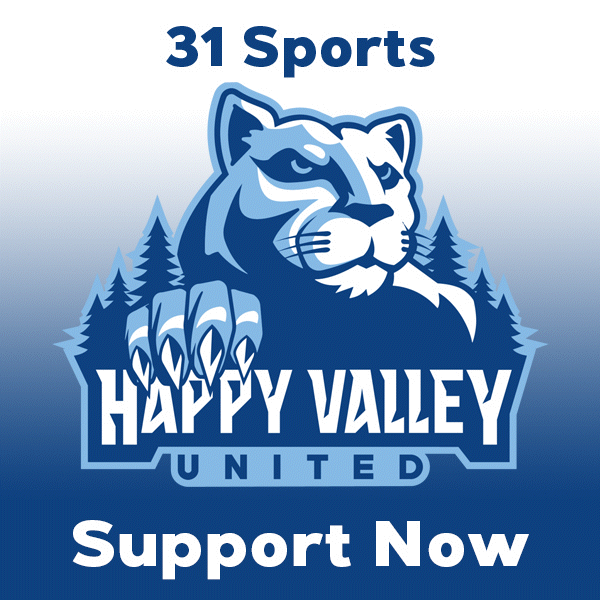Sunday Column: A Few Ways to Make the Blue-White Game More Colorful

Penn State will hold its final spring football practice in a week. Most years, it’s called the Blue-White Game, and it’s attended by as many as 70,000 fans, who probably aren’t dying to see how the third-string left tackle looks or who will be the next Aric Heffelfinger as much as they are just looking to scratch a football itch as they wait for September.
This year, the details are foggier, but we know that Penn State freshmen will be allowed inside the stadium to watch this practice or game or scrimmage or whatever it’s going to be. For the rest of us, it’s an opportune time to consider how the Nittany Lions might tweak the format in future, pandemic-free years of what is usually, after the initial excitement of seeing dudes in helmets and pads wears off, a fairly dull afternoon.
Some humble suggestions, with reasons why they would and wouldn’t work:
The 7 on 7
Quarterbacks slangin’ the tater. Receivers and corners squaring off in a running chess match. This format, which typically substitutes flags for live tackling, grates on traditionalists but there’s no denying the fast-paced appeal to both casual and knowledgeable fans.
Pros: A chance for Sean Clifford and at least one of Penn State’s young quarterbacks to build rhythm and confidence, not to mention rapport with their receivers. Virtually no chance of injury for linemen other than perhaps a bad sunburn.
Cons: Doesn’t really help the team prepare for what’s coming in the fall, which is supposed to be the point of every spring practice. Not exactly an ideal way for the defense to sharpen its tackling habits.
The Lions’ Den
This traditional drill, also known as the Oklahoma drill, puts a ball carrier in the crosshairs of four tacklers, with three linemen to back him up. The catch? He has to maneuver past everyone in super-tight quarters.
Pros: The intensity of this exercise is, ahem, unrivaled among football activities, and it would be a nice reward for players after a full spring of hard work. It might be the closest thing you can get in the ultimate team game to a one-on-one format.
Cons: Depending on the number of players that combine to form the “perimeter” of the den, it can be difficult for fans to see exactly what’s going on, depending on their vantage point. Also, it’s pretty much a given no one will ever top THIS, so maybe they shouldn’t even try?
The OT
Run a regular Blue vs. White scrimmage, only have every possession start from the opponent’s 25-yard line, as is done in, yup, overtime. Don’t overthink this, people.
Pros: Practice is all about situational football, right? The playbook gets a bit limited near the end zone for offenses, and the more experience both the offensive and defensive units get in these situations, the more ready they’ll be when their legs are shot but they need a score (or to prevent one) in overtime this Halloween in Columbus (wink wink).
Cons: This could get boring really quickly, just as a regular scrimmage does. And just because Penn State’s quarterbacks rarely threw passes of longer than 10 yards last year doesn’t mean they won’t need to practice them.
The Elway
This one is similar to The OT, but this time the offense starts each drive pinned deep in its own territory – say, inside the 10 – with under two minutes on the clock and just one timeout.
Pros: Again, good practice for both units in specific pressure situations. And it might not hurt the coaching staff to get extra work at getting the calls in and managing the clock, either.
Cons: Ideally, the spring game builds the confidence of the fan base in the team. Even if it’s more the result of the defense playing well, fans watching the offense failing to convert more than one or two of these situations could suck enthusiasm out of the season before it starts.
The Boot Camp
Many of Penn State’s practices end with kickers having to connect on a pressure kick; they miss, the whole team runs. They make, they celebrate. Instead of sprints, Penn State could bring in local sponsors to reward fans. For example, a successful 40-yard field goal would be a free box of grilled stickies for everyone in attendance, or a 55-yarder would win a semester’s worth of textbooks for 10 undergrads.
Pros: Never hurts to make sure your kickers have practice in pressure situations, especially in front of people. Bring in a cymbal player from the Blue Band for an extra degree of difficulty.
Cons: See enthusiasm-sucking reference above. If your kickers have had a bad spring, you don’t want to put them on display and wreck their confidence.
The Armchair QB
Run a normal, full scrimmage, but pre-select four lucky fans – two for Blue and two for White – to call the respective plays for the offense and defense using a dumbed-down play sheet.
Pros: As close to a video game as it gets for fans, who would hopefully gain a fuller appreciation of what the coaches have to deal with each week.
Cons: The lucky fans would have to be locked in a storage closet, of course, until January to avoid any leaks.
Some of these lend themselves to natural combos – The Boot Camp and The OT would be a nice pairing, for example, or maybe you’d prefer The Elway with a Lions Den chaser. In any case, these modified formats would allow coaches and players to get some important work done and at the same time get the Blue-White Game back to what it was always supposed to be – a fun spectacle for the people who will ensure Beaver Stadium is a true home-field advantage in the fall.




Leave a Comment